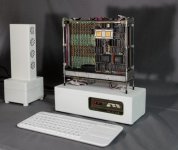Oscar
Experienced Member
Hi,
I just visited Joerg Hoppe, who built a project very much in this spirit as well:
http://retrocmp.com/projects/lsibox
In the power supply base of the unit, he added simulated storage devices using a BeagleBone. So it behaves like a pretty well-equipped 11/73 in fact!

Kind regards,
Oscar.
I just visited Joerg Hoppe, who built a project very much in this spirit as well:
http://retrocmp.com/projects/lsibox
In the power supply base of the unit, he added simulated storage devices using a BeagleBone. So it behaves like a pretty well-equipped 11/73 in fact!

Kind regards,
Oscar.
